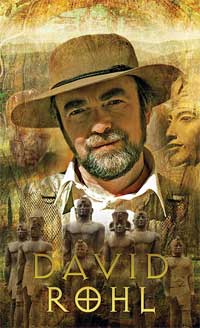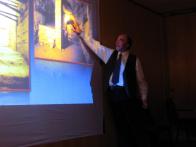David Rohl – ‘Testing Time -the New Chronology in 2009’. A morning and afternoon presentation of three lectures by the author of A Test of Time, Legend, and several other books concerned with the revision of the chronology of ancient Egypt and surrounding nations. Full report in C&C Review 2010.
- Lecture 1 – ‘Conundrums of the Pharaohs: reasons why the orthodox chronology is wrong’.
- Lecture 2 – ‘Legendary Kings and Chronicles: the United Monarchy in the New Chronology’.
- Lecture 3 – ‘The Israelites in Egypt: evidence for the Sojourn, Exodus and Conquest’.

Harlequin Theatree, Warwick Quadrant, Redhill, Surrey. Member’s Autumn Lecture Meeting. (Also open to the general public). David Rohl – ‘Testing Time -the New Chronology in 2009’. A morning and afternoon presentation of three lectures by the author of A Test of Time, Legend, and several other books concerned with the revision of the chronology of ancient Egypt and surrounding nations. Full report in C&C Review 2010.
- Lecture 1 – ‘Conundrums of the Pharaohs: reasons why the orthodox chronology is wrong’.
- Lecture 2 – ‘Legendary Kings and Chronicles: the United Monarchy in the New Chronology’.
- Lecture 3 – ‘The Israelites in Egypt: evidence for the Sojourn, Exodus and Conquest’.
SIS AUTUMN LECTURE MEETING – TOOK PLACE ON 19TH SEPTEMBER 2009 full report in C&C Review 2010 – available to non-members Full day presentation of three lectures by the author of A Test of Time and many other books concerning the New Chronology DAVID ROHL ‘TESTING TIME – THE NEW CHRONOLOGY IN 2009′
It is now coming up to ten years since the New Chronology was brought to the world’s attention through the publication of A Test of Time and the television broadcast of ‘Pharaohs and Kings’. Of course, the SIS has been privy to several new developments since the early 1980s (25 years now). During that time huge strides have been made in New Chronology research; ranging geographically from ancient Egypt to Greece, and scientifically from linguistics to radiocarbon dating. There have also been several attempts to undermine the pillars of the New Chronology by orthodox scholars, but after examination by neutral researchers such criticisms were found to be either spurious, or not the fatal blow to the new theory that orthodoxy had claimed.
As an archaeologist, Egyptologist and ancient historian David has challenged those who regard Old Testament history as being of little real value and identifies Ramesses II of the 19th Dynasty in Egypt as the ‘Shishak’ of the Old Testament, who sacked the temple of Solomon. He has written many articles and books concerning what he has named the ‘New Chronology’ and, over the years, has gained many adherents.
 ‘Little conclusive evidence for an historical Old Testament has come to light in two centuries of archaeological endeavour. Ever since excavations in the Lands of the Bible began at the beginning of the last century, biblical scholars have been systematically stripping out elements of the narratives – the stories of Joseph, Moses, Joshua, Saul, David and Solomon – and consigning them to the realms of myth and folklore.
‘Little conclusive evidence for an historical Old Testament has come to light in two centuries of archaeological endeavour. Ever since excavations in the Lands of the Bible began at the beginning of the last century, biblical scholars have been systematically stripping out elements of the narratives – the stories of Joseph, Moses, Joshua, Saul, David and Solomon – and consigning them to the realms of myth and folklore.
‘The New Chronology developed in A Test of Time reveals the true historical setting of the biblical epics, providing astonishing archaeological evidence for the existence of the Old Testament’s most charismatic personalities. [………..] the lives of Joseph, Moses, Joshua, Saul, David and Solomon are examined from an historical perspective, as David explores their cities, palaces and tombs. A Test of Time unveils such archaeological wonders as the desecrated statue of Joseph in his “coat of many colours”, the Israelite city of bondage in Egypt (including graphic evidence of the plagues), and letters from King Saul’ (Extracts from inside jacket cover of A Test of Time. The Bible – From Myth to History)
David presented three lectures to outline both old and new evidence for the New Chronology, with all the visuals that he is well-known for (photographs, charts, tables and graphics).
